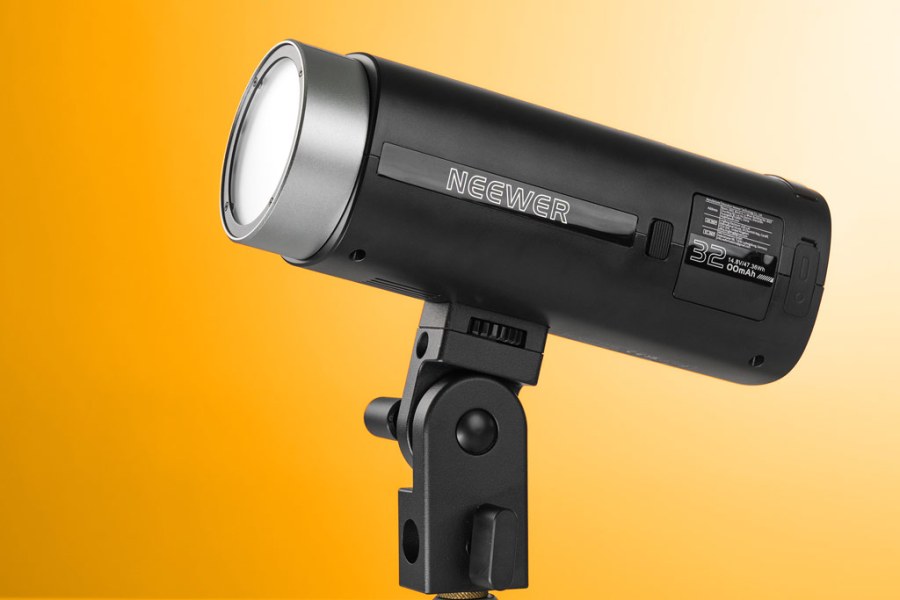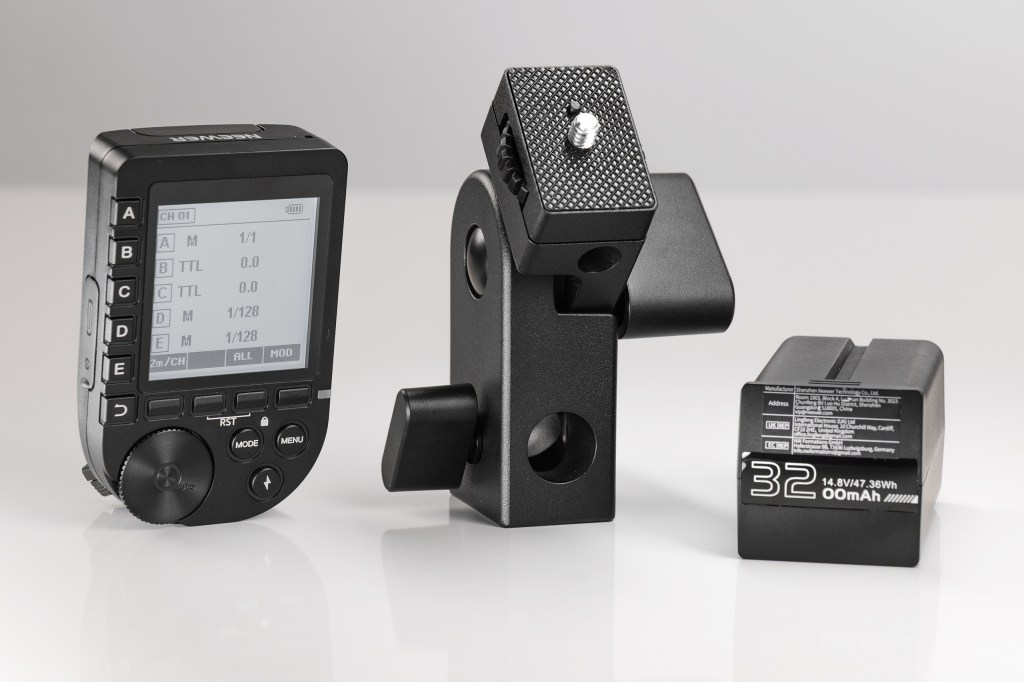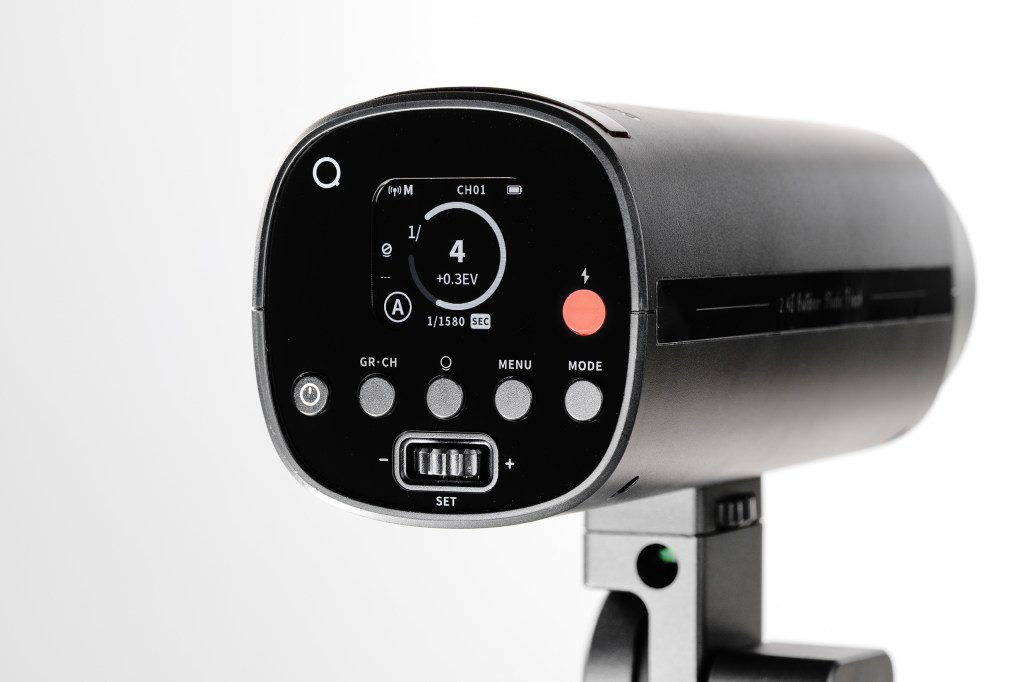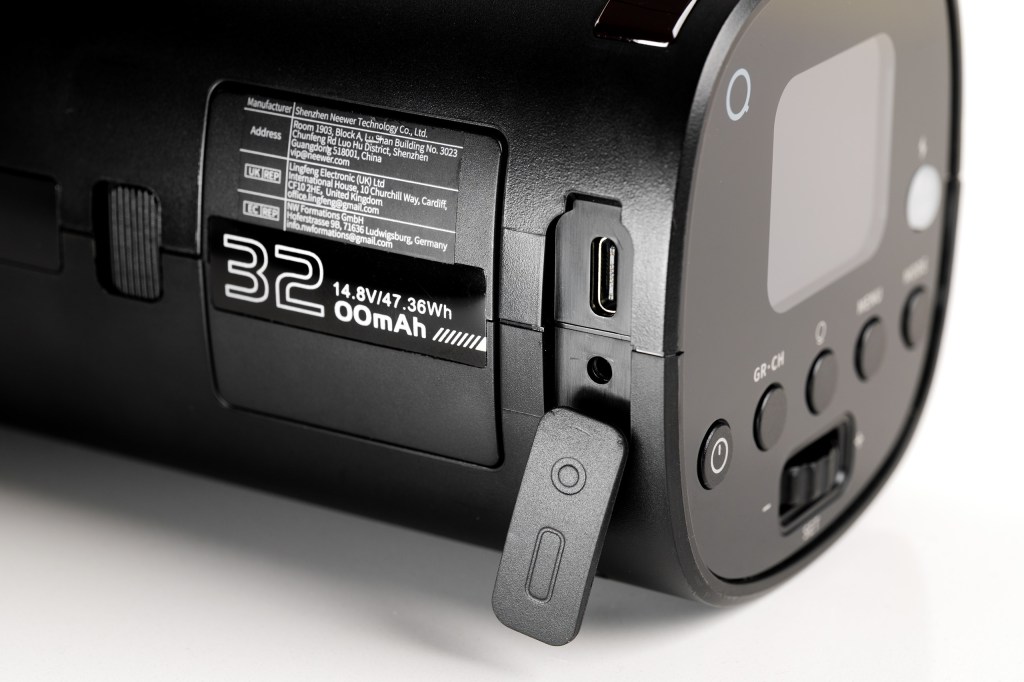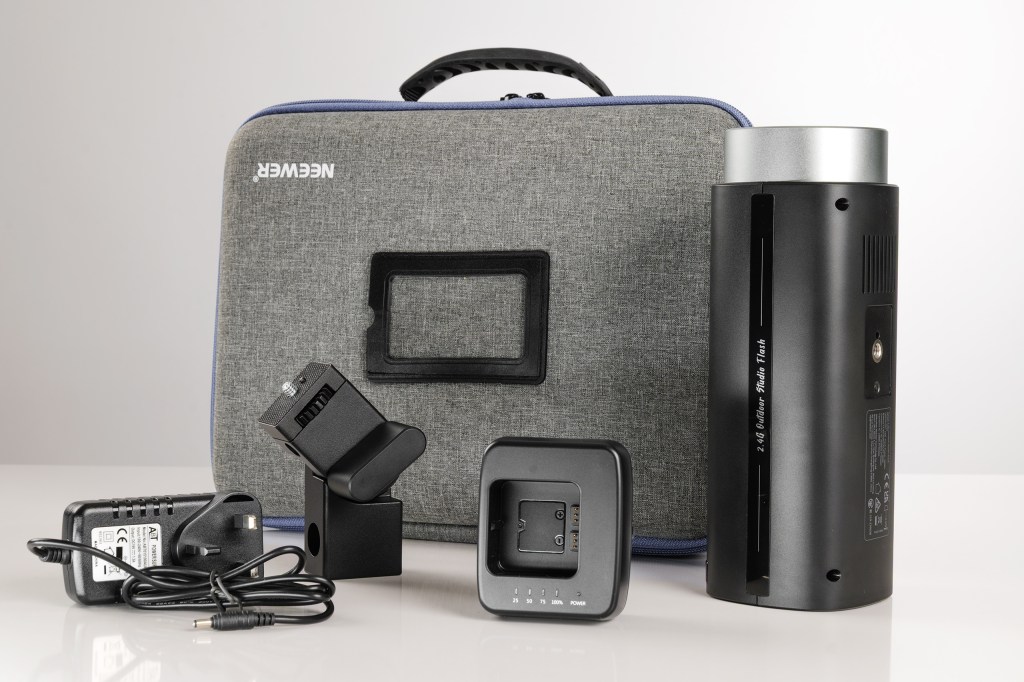Amateur Photographer verdict
The Neewer Q200 works very well, and delivers a good amount of power in a consistent and reliable manner. It represents a good entry option to off-camera flash systems- Great power/price ratio
- Easy enough to use
- Lots of advanced options on offer
- Really good light stand adapter
- Excellent app
- Needs an adapter to take full sized modifiers
- No mains or in-body charging means a spare battery will be needed for long shoots
Neewer Q200 at a glance:
- Battery powered studio-style flash
- $299 / £289
- 750 full powered bursts per charge
- Remote control via app, control unit and other flashes
- Built-in 10W LED bi-colour modelling lamp
- Full to 1/256th power bursts
- 100 pops per second in multi-burst mode
Most flash manufacturers in the last thirty or so years have adopted quite conservative, and perhaps quite dull, designs for their portable and studio flash units. Flash guns don’t need to be sexy, I know, but it is nice to have a bit of fun even with practical tools that rarely appear in the pictures taken with them. We used to have great hammer head guns like the Metz 45 series, hotshoe bulbs set into mini reflectors that looked like satellite dishes, and bare bulb units like the Sunpak 120j (if you remember them), as well as little poppy units designed for equally little cameras. There have been a few exceptions in recent years, but most hotshoe guns now look much the same, in the way that cars began to lose their individualism around the time the Ford Sierra was launched in the early 1980s. Godox has made an effort and has reaped the benefits, firstly with its massively popular AD200 series and then with the groovy Lux Senior and Junior Retro flashes – which all mixed a bit of style with good practical purpose and performance.
Neewer has also been busy at the design desk creating flash units that bring new concepts to the category with its Q series, and this new Q200 is the first of what promises to be a collection of tube-shaped units. It is too big to go on top of the camera but, at about the same size as a 70-200mm f/2.8 zoom, it is small enough to fit in your camera bag. Designed for the outside as well as the studio, this battery-powered head offers something a bit different alongside some enticing specifications.
Neewer Q200 – Features
The Neewer Q200 is a 200Ws flash unit designed to be mounted on a stand or pole and used outside as well as indoors. In manual mode it offers 9 levels of power output, from full power to 1/256th, and owners of Canon, Fujifilm, Nikon and Sony cameras can benefit from TTL control via the optional Neewer QPRO wireless trigger – which will trigger and control the flash from any make of camera if you don’t care about TTL control. I don’t, and used the Nikon trigger on my Lumix cameras. The days of AA battery-powered flash units are numbered, and this model gives us a 3200mAh lithium ion block battery (spares will be about £55 later this year) that Neewer claims is good for 750 full power bursts. The battery is removable, and charges in 3 hours in the charging block that comes in the kit.
Neewer says the flash is balanced for 5600K, but we also have a built-in LED modelling light with 10W of power and the ability to shift its temperature from a warm-glow 2700K to a chilly blue 6500K. We can ask the flash to fire at the beginning or the end of the exposure, and when we need shutter speeds shorter than the camera’s standard sync speed (usually 1/250th) a high speed mode pops lots of bursts in quick succession to ensure the whole frame is covered at shutter speeds as short as 1/8000sec. The shortest flash duration is listed as 1/13,510sec, so it will be great for freezing motion.
Wireless control is achieved using the 2.4GHz network, and through Neewer’s Q system the flash can be operated via the already mentioned QPRO hotshoe controller, or we can use the Neewer app to trigger the flash and to alter almost all of its settings. The network also allows the Q200 to operate alongside other Neewer flash units, such as the Neewer Q4 we reviewed in AP issue 4th March 2025. Six groups of flash units can be controlled from the QPRO controller or from one of Neewer’s Q-system speedlight heads. I’m pleased to say that Neewer has made this unit compatible with all flash units via its optical slave cell – so any flash will trigger it, if not actually control it. There is also a 2.5mm sync port for cable triggering too, which also allows rear-curtain triggering.
Like some other Neewer flash units the Q200 has a Mask feature built-in, so that when shooting with other units we can automatically create individual images for the subject and the background that can be either merged with more control after the event or used to create a mask for cut-outs. We also get timelapse mode, a delay of up to 30 seconds, power adjustments in 1/3rd or 1/10th stops, and a fan to keep it all cool.
Neewer Q200 – In use
A key element of consideration is that the Neewer Q200 isn’t immediately compatible with regular studio-style modifiers. The rounded barrel and end has no physical mount for softboxes and dishes, so we need the Neewer CRB1 (£42) adapter to make Bowens accessories fit. You may have other similar adapters that are commonly designed for speedlight style flash units, but because this head is round and not rectangular you’ll need the specific model made by Neewer – and which also fits the company’s round-head speedlights. There is an accessory range for the Z series speedlights that includes a dome diffuser, coloured gels, gobos and mini-barn doors, and these will attach magnetically to the front of the Q200. They are small so they will always produce a harder light, but it’s clever kit.
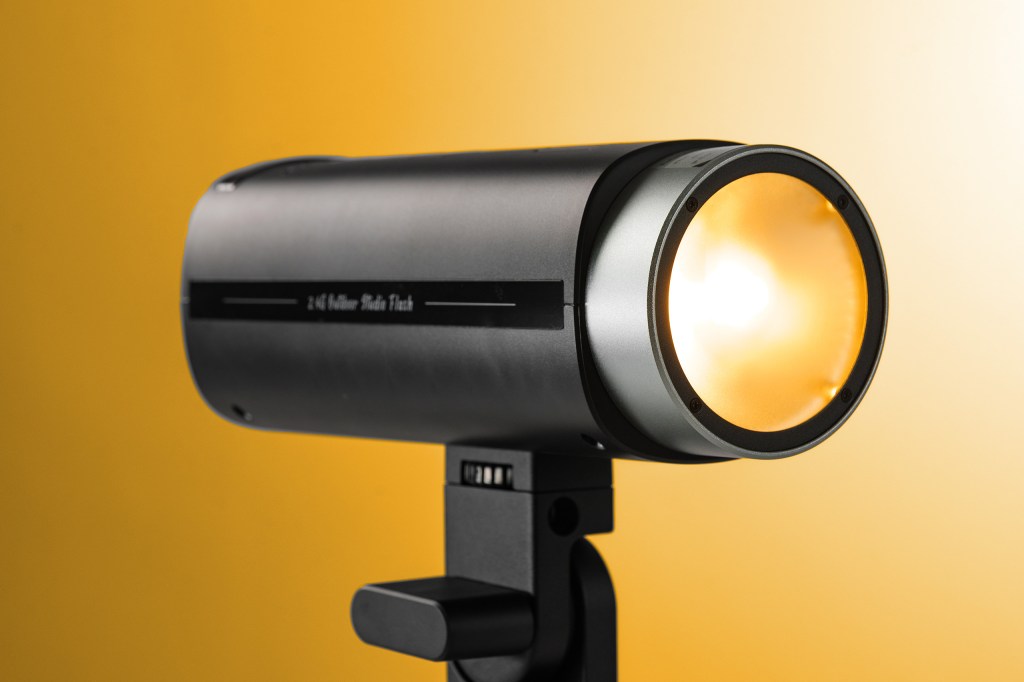
As with the other flash units I’ve used from Neewer, the Q200 has a well-designed menu and is reasonably simple to use. The kit comes with a very nicely made light stand adapter that features a brolly hole, two ways to mount, and a locating pin beside the screw that connects with a dimple on the underside of the light. So once it’s screwed into place, the Q200 won’t rotate on the adapter if the screw gets a bit lose. The whole of the adapter head fits neatly into an indented area on the base too, so we are doubly protected from accidental rotations. No one is going to buy the flash on account of the quality and design of the stand bracket, of course, but if there were awards for such things Neewer would be winning them.
Should the ‘on’ button be accidentally pressed in transit or when you don’t want the light to be on, a two-stage lock system prevents it from coming on fully – and puts it back to sleep after a few seconds. To activate the light, we press the ‘on’ button and then rotate the control wheel. This isn’t an original feature, but it will save accidental battery drain and a hot LED light burning away inside the case.
All our control buttons and the display screen are positioned on the rear of the unit. Other than the on/off button and the flash test button there are four buttons and a control wheel to guide us through the menu and the functions of the light. The purpose of each of the buttons is pretty obvious, and scrolling through the menu shouldn’t present too many problems. There are few things you’ll need to refer to the manual for, but they may include how to adjust the colour and brightness of the modelling light, and discovering the buttons all offer additional controls after a long press. It isn’t hard though.
The flash test button glows red when the unit is ready to go, and pulses when we need to aware of something. There’s an optional audio bleep to indicate the flash is fully charged, and the modelling light can be set to be always on at a set power, to go off when the flash isn’t recycled and to produce output proportional to the power setting of the flash.
Neewer Q200 – Performance
If you aren’t sure what to expect from a 200Ws flash unit set to full power, the Q200 will give you an aperture of f/11 1/3rd when the unit is 2m from the subject and the camera set to ISO 100. That’s more than enough to operate on a sunny day and compete with, or overpower, the sun, and about the same you’d get from a GN58m hotshoe gun or the Godox AD200 Pro ll. I tested the exposure multiple times and found only a minor variation of 1/10th stop between all the full power bursts I measured, and discovered that the flash takes only a second and a half to be ready to go again. At lower power settings there is practically no delay at all. At ¼ power the flash will fire as quickly as you are able to press the shutter release on your camera, and below ¼ power we can enjoy multi-mode pulses – at a rate of up to 100 per second. From 1/16th power Neewer describes the output as ‘continuous’, which for all regular intents it is.
The built-in disc diffuser over the front of the unit covers both flash tube and LCD modelling light, so the spread of light from the two are reasonably consistent. While the power of the modelling light is dramatically different to that of the flash it will give a decent idea of where the light will fall and how it will spread. The modelling light is also bright enough to shoot with on its own if conditions aren’t too bright – even if just to fill shadows.
One of the more impressive elements of this kit is how quickly and easily it connects with the QPRO controller and with the smartphone app. Connection from off to ready takes about ten seconds, and there is no delay between the units when adjusting settings or triggering a burst of light. I’ve mentioned it in previous reviews, but it’s worth saying again: the Neewer app and the QPRO control unit are both excellent (just not at the same time, as they use the same frequency). One quirk, though, is that by default the QPRO won’t allow us to wind the output down to 1/256th – it will stop at 1/128th. You can fix this though through the trigger’s setting menu by changing the incremental power adjustments from the standard 1/3rd stop to 1/10th stop.
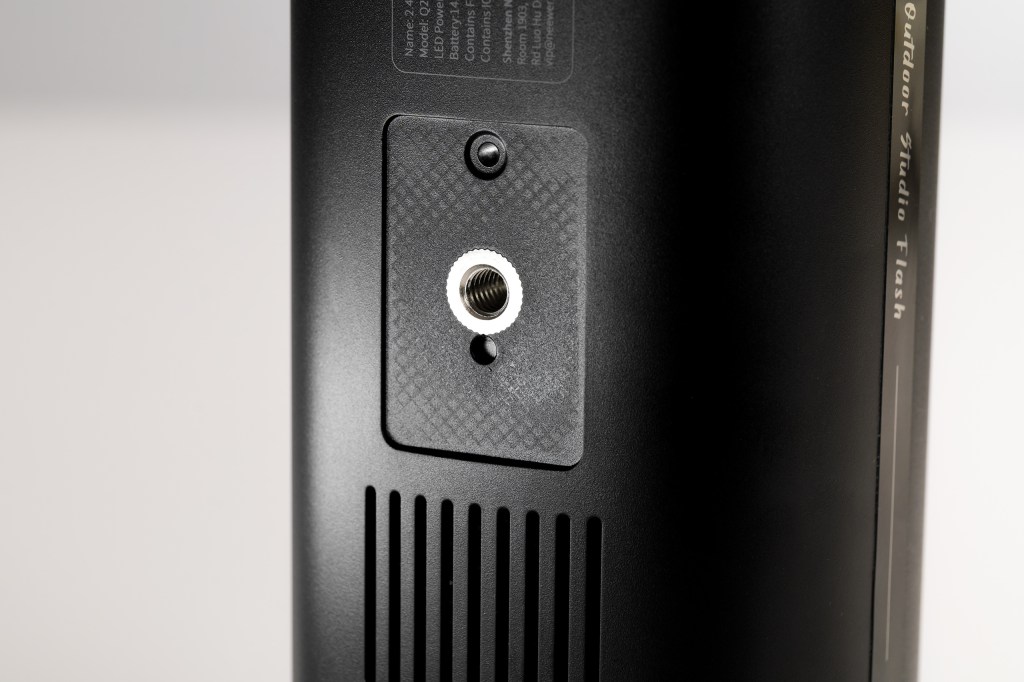
Another concern was that in some cases the flash couldn’t discharge the built-up power when turning the output down from full to 1/4, for example. The red light would flash and the first pop would be at the higher power setting – only dropping to ¼ power after discharge. I’m not sure why this happened, and I can’t make it happen again, but it was during a session of some intensive and extensive use.
I haven’t tested Neewer’s specific claims about battery life, but I can tell you I have no reason to doubt that the battery will deliver 750 full power bursts. I’ve used this flash a lot so far and haven’t had to charge it yet.
Neewer Q200 – Conclusion
I’ve been through quite a lot of Neewer products in recent months, and all seem to have common characteristics. They perform very well, are very well featured and they cost less than one might expect, and usually much less than the competition.
This Neewer Q200 is an interesting product and its shape makes it stand out from the crowd, while at the same time blending in with the company’s round-headed speedlight range. I can’t find much reference to the qualities that make it especially an ‘outdoor’ light, other than its reliance on a battery instead of the wall, but I guess it also has a moisture resistant body and won’t take in the dust – though the fan vents top and bottom suggest there may be some weaknesses in its armour.
The lack of a native Bowens mount can be overcome with the CRB1 adapter and actually Neewer has a good range of brollies to go with the light, including some big ones with diffusing covers that effectively make them softboxes.
The Neewer Q200 works very well, and provides a good amount of power in a consistent and reliable manner. And it looks quite fun. It makes a great purchase, and a good entry into the growing Neewer off-camera flash system.

Full Specifications
| Flash Modes | M/MULTI (Wireless Off), TTL/M/MULTI (2.4G Wireless Mode) |
| Camera Brands for 2.4G Wireless Mode | Compatible with Nikon, Canon, Sony Cameras |
| Flash Output Power | 200Ws |
| Flash Duration | 1/220s-1/13510s |
| Flash Power | 1/256-1/1 |
| Delay Flash | 0.01-30s |
| Optical Triggering | S1/S2 |
| Wireless Controlled Groups | A, B, C, D, E |
| Wireless Transmission Range | 328ft/100m |
| Modeling Light Brightness | 1-10 Levels |
| Modeling Light Color Temperature | 2700K-6500K (±100K) |
| Strobe Flashing | Times: 100; Frequency: 100 |
| Sync Modes | High Speed Sync, Front/Rear Curtain Sync |
| Recycle Time | 0.01-1.5s |
| Triggering Method | 2.4G/S1 Optical Trigger/S2 Optical Trigger |
| IDs | 01-99 |
| Channels | 01-32 |
| Power Supply | Lithium Battery |
| Battery Capacity | 14.8V/3200mAh |
| Maximum Power Flash Cycles | <750 Cycles |
| Charging Method | Plug-in Charging |
| Charger Voltage | DC 19V |
| Dimensions | 3.2″x3.2″x8.7″/81x81x220mm |
| Weight (including battery): 2.2lb/988g | 2.2lb/988g |
Related reading:
- Neewer Q4 flash review – solid, powerful and value for money
- Neewer HB80C RGB COB LED light review
- Manfrotto Lumie Series LED lights review

